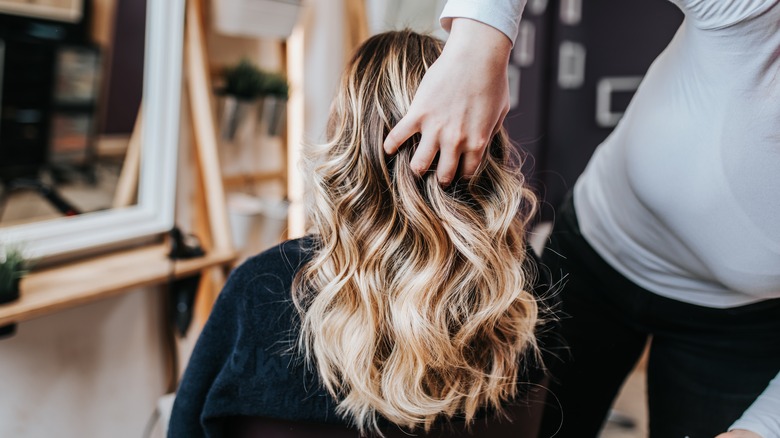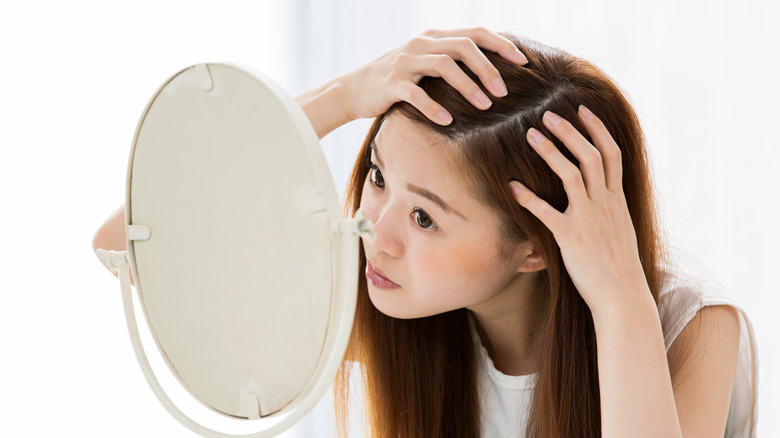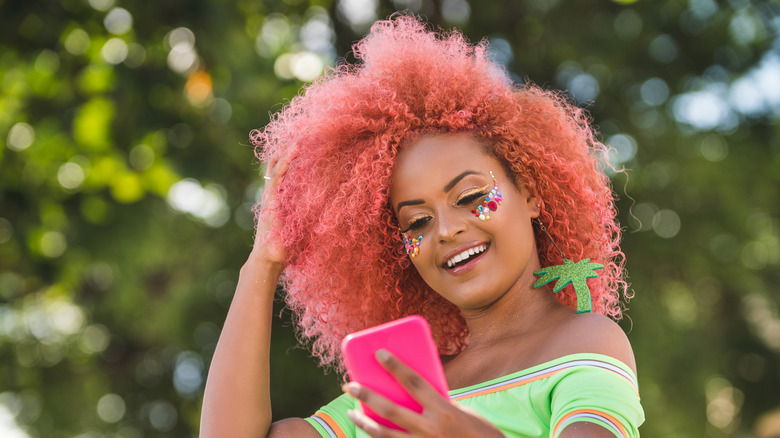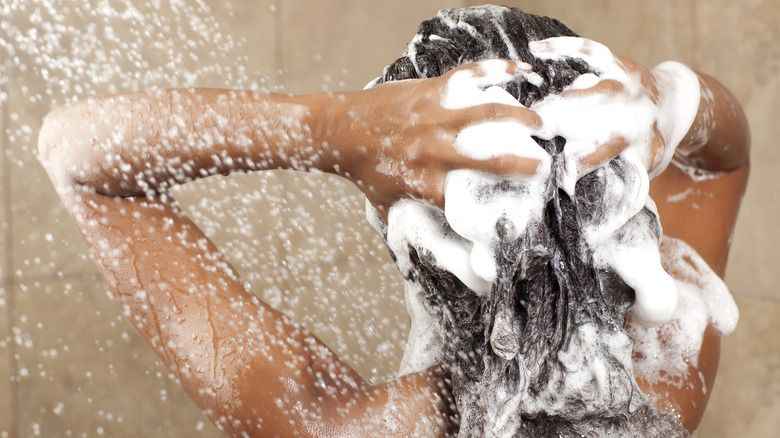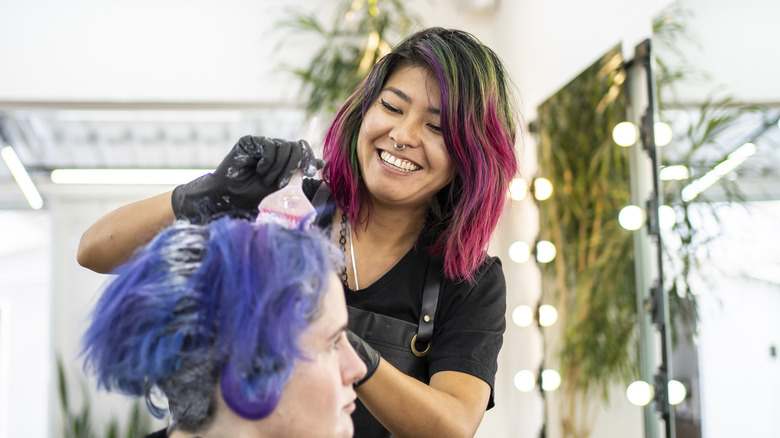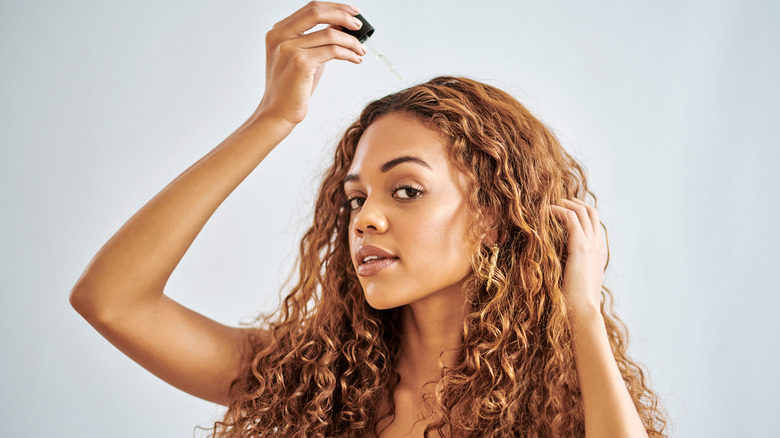Everything You Need To Know If You're Dyeing Your Hair For The Very First Time
We may receive a commission on purchases made from links.
Dyeing your hair is equal parts exciting and terrifying. Just like a haircut, it can be an extreme change, like experimenting with blue hair, or a simple enhancement, like highlights. Regardless, if you're dyeing your hair for the first time, there are a number of ways to prepare from pre-to-post haircare. It's always best to go into the process knowing what to expect, as well as the impact dye has on hair (and deciding whether your hair can handle it).
"The first thing I tell my clients is that hair coloring is a process and though we're aiming for a particular look, preserving the health of your hair is just as important," hair colorist Adriana Tapia explained to The Zoe Report. Depending on the color you're going for — platinum blue, electric purple, or even hot pink inspired by Barbiecore — it's best to know what each color entails and how often you'll need to re-dye it. For example, balayage is one of the easiest hair dye styles to maintain, with the freedom to grow your hair out or retouch it every six to 12 months, much less frequently than full-head dyes.
If your budget allows, it's best to go to a salon for your first hair dye, as a professional stylist will help you navigate this new journey. If that's not feasible, though, we've got you covered. Women's guide to dyeing your hair for the first time can help you settle on color, style, and pricing.
Address your hair health beforehand
Before you start searching the internet for inspiration, it's best to make sure your hair is healthy enough to be dyed. Certain colors will take more time, effort, and endurance, and that might not be something your hair can tolerate. If you're experiencing hair loss and thinning, it may be best not to apply dyes to the roots and instead focus on highlights or hair lighteners.
According to Pantene, the chemicals in hair dye will inflict some form of damage, as it's not possible to dramatically change hair color without products like bleach or peroxide. These dyeing agents are strong, and that can cause damage to hair that is especially sensitive to products.
On the other hand, if you're lucky enough not to struggle with genetic hair loss or damage from years of heat styling, dyeing your hair might be great for you. Depending on the dye you choose, you'll likely be revisiting the salon every four to six weeks. Discuss with your hairstylist whether your hair is in the right condition to be dyed, or if there are certain styles and dye jobs that will work best with your natural hair texture and color.
Choosing a look
When it comes to choosing the right hair color, pictures of celebrities are your best friend. You'll want to pick a style and color that naturally compliments your skin tone and roots. "If you have a pink skin tone, you want to stick with a cooler, ashier tone, " celebrity hair colorist Kari Hill explained to Seventeen. "If you have a yellow skin tone, you can go with the golds and the warm [shades]. And if you have no idea what undertones you have, talk to your colorist — they should be able to help." Once you've decided what color looks best for you, you can search for examples through celebrity photographs and narrow it down to two or three photos.
After choosing a few photos, save them in a folder on your phone to show your stylist what look you're going for. They'll be able to help cherry-pick the best qualities from the photos you've chosen, and you can collaboratively decide on your new hair color and styling. Your colorist will also be able to provide suggestions that you may not have thought of, which make the pictures a great jumping-off point. You might suggest starting with an experimental strand, so you can decide whether the color suits your desired outcome.
Prepping before dyeing
You've chosen your inspiration, now let's prepare for your hair appointment! Before heading into the salon, it's best to wash your hair thoroughly. "I always ask my clients to use a clarifying shampoo before coming in for any kind of color treatment," explained celebrity colorist Matt Rez to The Zoe Report. "Not only does freshly-washed hair make it easier for the colors and lighteners to penetrate into the follicles, it can also help decrease the time and amount of heat that is required for processing, which will lessen overall damage."
With freshly washed hair, your stylist can get started with what you're most excited about. In addition, following up with a leave-in conditioner treatment can help moisturize and protect hair strands before dyeing.
There are a number of reasons why a clarifying shampoo is essential to the pre-dye hair routine, the most important being its removal of the build-up in the hair shaft. From low- to high-end, some of the best clarifying shampoos include Monday Haircare's Clarifying Shampoo ($8), Curls' Hair Under There Detox Tea Cleanser Shampoo ($12), and Colorproof's Clear It Up Shampoo ($38). With a clean scalp and hair strands, dye will last longer and stick more efficiently. In contrast, avoid clarifying shampoos post-dye to make sure the color doesn't fade.
Post-dye maintenance
After the dyeing process is finished, ask your stylist for a moisturizing gloss treatment to keep your hair hydrated. You should also avoid washing your hair for about 48 hours, according to celebrity stylist Cody Renegar. "If you wash it before then, there's a chance the color will fade," he explained to Real Simple. Once the 48-hour period is over, use a high-quality color shampoo to give it the best post-dye shine. "Moisture-rich shampoos are also very gentle on the hair, making them the best option for maintaining your hair's health and preventing your new color from fading," Renegar added.
The initial wash will be great for your new hair color to settle in and shine. Moving forward, avoid frequent shampooing by sticking to two to three washes per week, as it will increase the longevity of your hair color. You'll also want a follow-up appointment scheduled with your salon to check up on your hair and assess whether it requires touch-ups, trimming, and other upkeep.
Long-term maintenance
Once the new color has settled in, there are a few ways to maintain its longevity. When showering, opt to rinse your hair out with cold water rather than lukewarm. Among the many benefits of a cold shower, cold water helps maintain colored hair and seals hair cuticles while moisturizing the scalp, skin, and hair. Beyond shower hair care, avoid leaving hair out in the sun for too long, and instead go for protective hairstyles like braids, buns, or loose ponytails. "Long exposure to the sun will fade your color, so try to avoid it," explained celebrity hairstylist Glenn Ellis to Real Simple. If you have to be in the sun for long hours of the day, use a heat protectant to shield the hair from dryness, frizz, and split ends.
A new hair color — especially when it's your first time experimenting with hair dye — will take some time to maintain. You'll likely spend more time at the salon protecting your hair through toning, moisturizing, and trimming, helping you get the most mileage out of your freshly reinvented hair.
